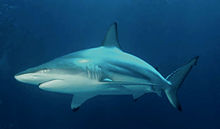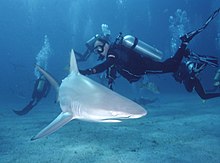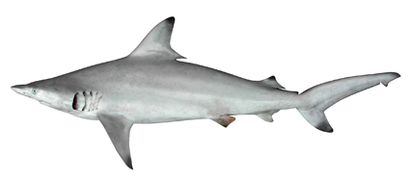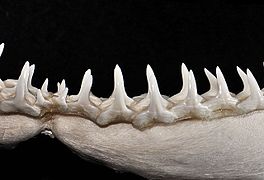Blacktip shark
| Blacktip shark | |
|---|---|

| |
| Scientific classification | |
| Domain: | Eukaryota |
| Kingdom: | Animalia |
| Phylum: | Chordata |
| Class: | Chondrichthyes |
| Subclass: | Elasmobranchii |
| Subdivision: | Selachimorpha |
| Order: | Carcharhiniformes |
| Family: | Carcharhinidae |
| Genus: | Carcharhinus |
| Species: | C. limbatus
|
| Binomial name | |
| Carcharhinus limbatus (J. P. Müller & Henle, 1839)
| |

| |
| Range of the blacktip shark | |
| Synonyms | |
| |
The blacktip shark (Carcharhinus limbatus) is a
Swift, energetic
Normally wary of humans, blacktip sharks can become aggressive in the presence of food and have been responsible for a number of attacks on people. This species is of importance to both commercial and recreational fisheries across many parts of its range, with its meat, skin, fins, and liver oil used. It has been assessed as Vulnerable by the IUCN, on the basis of its low reproductive rate and high value to fishers.
Taxonomy
The blacktip shark was first described by French zoologist
Phylogeny and evolution
The closest relatives of the blacktip shark were originally thought to be the graceful shark (C. amblyrhynchoides) and the spinner shark (C. brevipinna), due to similarities in morphology and behavior. However, this interpretation has not been borne out by studies of mitochondrial and ribosomal DNA, which instead suggest affinity with the blacknose shark (C. acronotus). More work is required to fully resolve the relationship between the blacktip shark and other Carcharhinus species.[6]
Analysis of mitochondrial DNA has also revealed two distinct lineages within this species, one occupying the western Atlantic and the other occupying the eastern Atlantic, Indian, and Pacific Oceans. This suggests that Indo-Pacific blacktip sharks are descended from those in the eastern Atlantic, while the western Atlantic sharks became isolated by the widening Atlantic Ocean on one side and the formation of the
Description
The blacktip shark has a robust, streamlined body with a long, pointed snout and relatively small eyes. The five pairs of
The coloration is gray to brown above and white below, with a conspicuous white stripe running along the sides. The pectoral fins, second dorsal fin, and the lower lobe of the caudal fin usually have black tips. The pelvic fins and rarely the anal fin may also be black-tipped. The first dorsal fin and the upper lobe of the caudal fin typically have black edges.
-
The blacktip shark has black markings on most of its fins.
-
Lower teeth
-
Upper teeth
Distribution and habitat

The blacktip shark has a worldwide distribution in tropical and subtropical waters. In the Atlantic, it is found from
Most blacktip sharks are found in water less than 30 m (98 ft) deep over continental and insular shelves, though they may dive to 64 m (210 ft).
Biology and ecology
The blacktip shark is an extremely fast, energetic predator that is usually found in groups of varying size.
Behaviour

Like the spinner shark, the blacktip shark is known to leap out of the water and spin three or four times about its axis before landing. Some of these jumps are the end product of feeding runs, in which the shark corkscrews vertically through schools of small fish and its
Blacktip sharks have a timid disposition and consistently lose out to
Feeding
Fish make up some 90% of the blacktip shark's diet.
Life history
As with other requiem sharks, the blacktip shark is
Mating occurs from spring to early summer, and the young are born around the same time the following year after a
The growth rate of this species slows with age: 25–30 cm (9.8–11.8 in) in the first six months, then 20 cm (7.9 in) a year until the second year, then 10 cm (3.9 in) a year until maturation, then 5 cm (2.0 in) a year for adults.[28][29] The size at maturity varies geographically: males and females mature at 1.4–1.5 m (4.6–4.9 ft) and 1.6 m (5.2 ft), respectively, in the northeastern Atlantic,[12] 1.3–1.4 m (4.3–4.6 ft) and 1.5–1.6 m (4.9–5.2 ft), respectively, in the Gulf of Mexico,[28][30] 1.5 and 1.6 m (4.9 and 5.2 ft) respectively off South Africa,[31] and 1.7 and 1.8 m (5.6 and 5.9 ft), respectively, off North Africa.[26] The age at maturation is 4–5 years for males and 7–8 years for females.[28][30] The lifespan is at least 12 years.[2]
In 2007, a 9-year-old female blacktip shark at the
Human interactions


Blacktip sharks showing curiosity towards divers has been reported, but they remain at a safe distance. Under most circumstances, these timid sharks are not regarded as highly dangerous to humans. However, they may become aggressive in the presence of food, and their size and speed invite respect.[2] As of 2008, the International Shark Attack File lists 28 unprovoked attacks (one fatal) and 13 provoked attacks by this species.[33] Blacktip sharks are responsible annually for 16% of the shark attacks around Florida. Most attacks by this species result in only minor wounds.[3]
As one of the more common large sharks in coastal waters, the blacktip shark is caught in large numbers by commercial fisheries throughout the world, using
The blacktip shark is popular with recreational anglers in Florida, the Caribbean, and South Africa. It is listed as a game fish by the International Game Fish Association. Once hooked, this species is a strong, steady fighter that sometimes jumps out of the water.[3] Since 1995, the number of blacktip sharks taken by recreational anglers in the United States has approached or surpassed the number taken by commercial fishing.[29] The International Union for Conservation of Nature has assessed the blacktip shark as Vulnerable, as its low reproductive rate renders it vulnerable to overfishing.[1] The United States and Australia are the only two countries that manage fisheries catching blacktip sharks. In both cases, regulation occurs under umbrella management schemes for multiple shark species, such as that for the large coastal sharks category of the US National Marine Fisheries Service Atlantic shark Fisheries Management Plan. No conservation plans specifically for this species have been implemented.[29]
References
- ^ . Retrieved 12 November 2021.
- ^ ISBN 978-92-5-101384-7.
- ^ a b c d e f Curtis, T. Biological Profiles: Blacktip Shark Archived 2007-06-29 at the Wayback Machine. Florida Museum of Natural History Ichthyology Department. Retrieved on April 27, 2009.
- ^ ISBN 978-0-520-23484-0.
- ^ a b c Froese, Rainer; Pauly, Daniel (eds.) (2009). "Carcharhinus limbatus" in FishBase. April 2009 version.
- PMID 18558373.
- S2CID 24521217.
- ^ Benson. R.N., ed. (1998). Geology and Paleontology of the Lower Miocene Pollack Farm Fossil Site, Delaware: Delaware Geological Survey Special Publication No. 21. Delaware Natural History Survey. pp. 133–139.
- ISBN 978-1-56164-409-4.
- ^ Martin, R.A. Albinism in Sharks. ReefQuest Centre for Shark Research. Retrieved on April 28, 2009.
- S2CID 34885027.
- ^ a b c d e Castro, J.I. (November 1996). "Biology of the blacktip shark, Carcharhinus limbatus, off the southeastern United States". Bulletin of Marine Science. 59 (3): 508–522.
- S2CID 84239046.
- doi:10.1071/MF01132.
- S2CID 11461458.
- S2CID 7207957.
- PMID 6644926.
- S2CID 85151561.
- PMID 16849197.
- S2CID 85900416.
- ^ a b c Barry, K.P. (2002). Feeding habits of blacktip sharks, Carcharhinus limbatus, and Atlantic sharpnose sharks, Rhizoprionodon terraenovae, in Louisiana coastal waters. MS thesis, Louisiana State University, Baton Rouge.
- .
- ^ S2CID 83856507.
- .
- S2CID 8747023.
- ^ a b c Capapé, C.H.; Seck, A.A.; Diatta, Y.; Reynaud, C.H.; Hemida, F. & Zaouali, J. (2004). "Reproductive biology of the blacktip shark, Carcharhinus limbatus (Chondrichthyes: Carcharhinidae) off West and North African Coasts" (PDF). Cybium. 28 (4): 275–284.
- doi:10.1139/f02-036.
- ^ JSTOR 1445560.
- ^ ISBN 978-2-8317-0700-6.
- ^ a b Killam, K.A. & Parsons, G.R. (May 1989). "Age and Growth of the Blacktip Shark, Carcharhinus limbatus, near Tampa Bay" (PDF). Florida Fishery Bulletin. 87: 845–857. Archived from the original (PDF) on 2016-12-15. Retrieved 2016-11-10.
- ^ Wintner, S.P. & Cliff, G. (1996). "Age and growth determination of the blacktip shark, Carcharhinus limbatus, from the east coast of South Africa" (PDF). Fishery Bulletin. 94 (1): 135–144. Archived from the original (PDF) on 2016-12-16. Retrieved 2016-11-10.
- .
- ^ ISAF Statistics on Attacking Species of Shark. International Shark Attack File, Florida Museum of Natural History, University of Florida. Retrieved on April 22, 2009.
External links
- Photos of Blacktip shark on Sealife Collection




